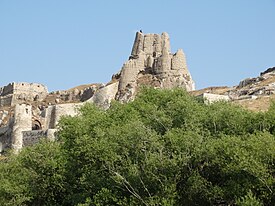Tushpa
Archaeological excavations and surveys carried out in the Van Province indicate that the history of human settlement in this region dates back at least as far as 5000 BC.
The fortress of Van is a massive stone fortification built by the ancient kingdom of Urartu and held from the 9th to 7th centuries BC.
A number of similar fortifications were built throughout the Urartian kingdom, usually cut into hillsides and outcrops in places where modern-day Armenia, Turkey and Iran meet.
Successive groups such as the Armenians, Romans, Medes, Achaemenid and Sassanid Persians, Arabs, Seljuqs, Ottomans and Russians each controlled the fortress at one time or another.
The lower parts of the walls of Van Citadel were constructed of unmortared basalt, while the rest was built from mud-bricks.
[3] In the trilingual Behistun inscription, carved in the order of Darius the Great of Persia, the country referred to as Urartu in Babylonian is called Armenia in Old Persian.
A stereotyped trilingual inscription of Xerxes the Great of the 5th century BC is inscribed upon a smoothed section of the rock face, some 20 metres (66 feet) above the ground near the fortress of Van.
Burnouf's reading of the Van trilingual inscription had made a significant contribution to the deciphering of Old Persian cuneiform.
It became an important center during the reign of the Artaxiad Armenian king, Tigranes II, who founded the city of Tigranakert in the 1st century BC.
[1] The Byzantine Empire briefly held the region from 628 to 640, after which it was invaded by the Muslim Arabs, who consolidated their conquests as the province of Ermeniye.

